
The design of training courses is a systematic work. Therefore, training lecturers must follow certain steps when designing training courses, such as analyzing course objectives and determining course objectives.
Training course design steps
1. Analysis training course
The analysis of training courses is an important step in training management. The overall goal of the analysis phase is to determine the job knowledge and skills that students must master.
2. Determine the curriculum goals
(1) The principle of setting goals
Setting course goals should be in line with the SMART principle.
(1) S (Specific)-clarity. The so-called clarity is to use specific language to clearly explain the goals to be achieved. Many training courses fail to achieve the desired results because the goals are set ambiguously, or the goals are not effectively passed on to the relevant students.
(2) M (Measurable)-measurable. There should be a clear set of data as the basis for measuring whether the goal is achieved.
(3) A (Achievable)--Achievable. When setting training course goals, it is necessary to set goals that can be actually achieved through training based on the actual situation such as the quality and experience of the students, and guided by the actual work requirements.
(4) R (Realistic)--practicality. The practicality of the goal refers to whether it is feasible and operable under realistic conditions. The practicality of the goal should be seen from two aspects: first, whether it is too difficult to achieve; second, whether it meets the company's input and output expectations for this goal.
The development of training is also affected by factors such as training budget, venue, and time, as well as the support of leaders, as well as the students' academic qualifications, cultural qualities, and receptivity. Therefore, when setting training course goals, these influencing factors should be fully taken into account, and the determined training goals should be in line with the actual situation.
(5) T (Time-based)-time-bound. The time-bound nature of the goal means that the goal is time-limited. There is no way to evaluate a goal without a time limit, or the evaluation results may be unfair. Methods that do not have a clear time limit will also bring injustice to the assessment, harm the working relationship, and harm the enthusiasm of subordinates.
(2) The form of setting curriculum goals
The form of setting course goals is shown in Table-1 for details.
Table-1 The form of setting course goals
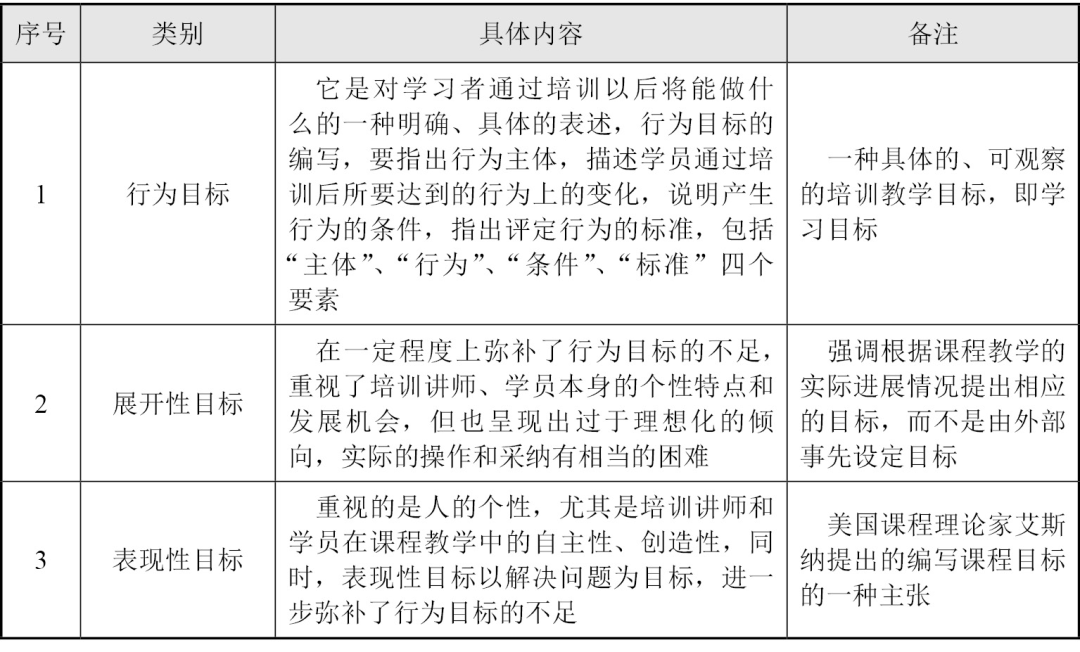
3. Write the syllabus of the course
The syllabus of the course is the preliminary idea of the training content and training method after the training objectives are clarified. The syllabus sets a direction and framework for the course, and the entire course will be enriched and extended step by step around this framework.
(1) The process of writing the syllabus of the course
When writing the course outline, the training lecturer first writes down the topics according to the course objectives, and then sets up a framework for the outline, writes down the specific content of each item you want to talk about, selects the teaching method of each item, and finally modifies and readjusts the arrangement. Content.
(2) Design appropriate content
To design appropriate content, the factors that training lecturers should consider include the applicability, feasibility, interactivity, relevance, and practicality of the course, as well as the coordination of the course content with the students' knowledge level. A template course outline is provided below for reference only.
【Practical example】
××Co., Ltd. Organizational Structure Course Outline
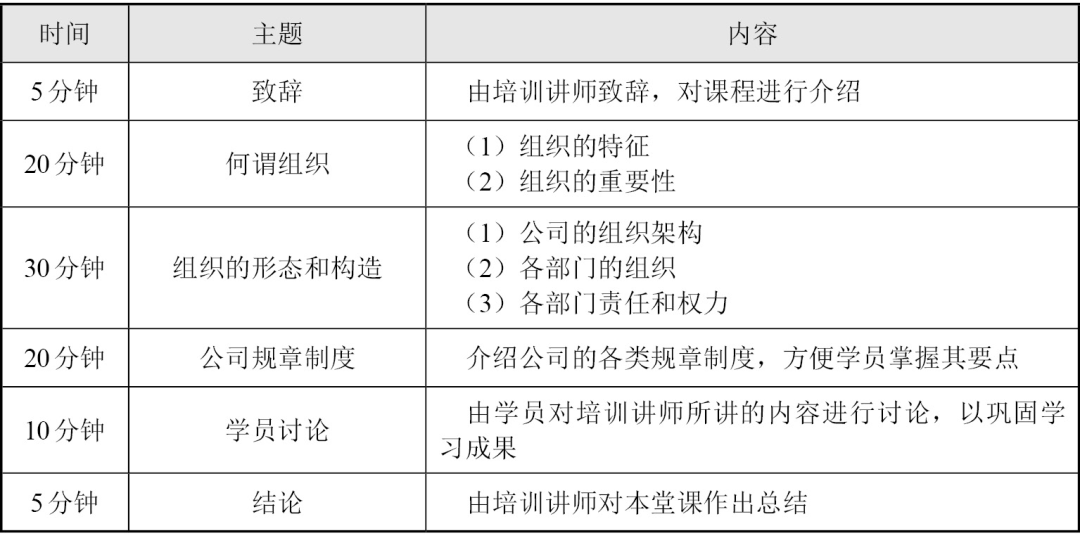
4. Course evaluation
Curriculum evaluation is a special evaluation activity, the purpose of which is to evaluate the curriculum and ensure the effectiveness and rationality of the curriculum. Course evaluation can be carried out in the following ways.
(1) Effective trial lecture
After the course design phase is completed, a trial lecture can be conducted. The trial lecture can be conducted alone, or you can invite others to assist. The trial lecture does not have to be carried out step by step in accordance with the designed course outline. You can also try a jumping trial lecture, take a paragraph at will, and start to express it. At the same time, imagine the real scene in the future and the possible reactions of the students, so that you can integrate yourself into the “real trial lecture” of the course.
If others cooperate to conduct a trial lecture, methods such as “role-playing trial lecture” can be used to show the training scene and atmosphere as truthfully as possible, and evaluate the training in communication and discussion.
(2) Objects of evaluation and feedback
The evaluation of the course should be obtained from every participant, observer and training instructor. Participants can include members of the target population, scheduled training lecturers, and project-related personnel. The only observer who cannot be lacking in the trial lecture is the course designer.
(3) Collect and analyze feedback
Ask those questions that need to be answered, and use those that are consistent with the questions in the evaluation sample. The sample includes questions and short-answer questions that students can score according to certain criteria. The scoring question (see Table-2) is easy to calculate and highly oriented. The short answer questions (see Table-3) take more time to organize and classify, but students can be encouraged to express their true feedback. However, the combination of these two problems in practical application can get the most effective feedback.
Table-2 Problems used in scoring evaluation
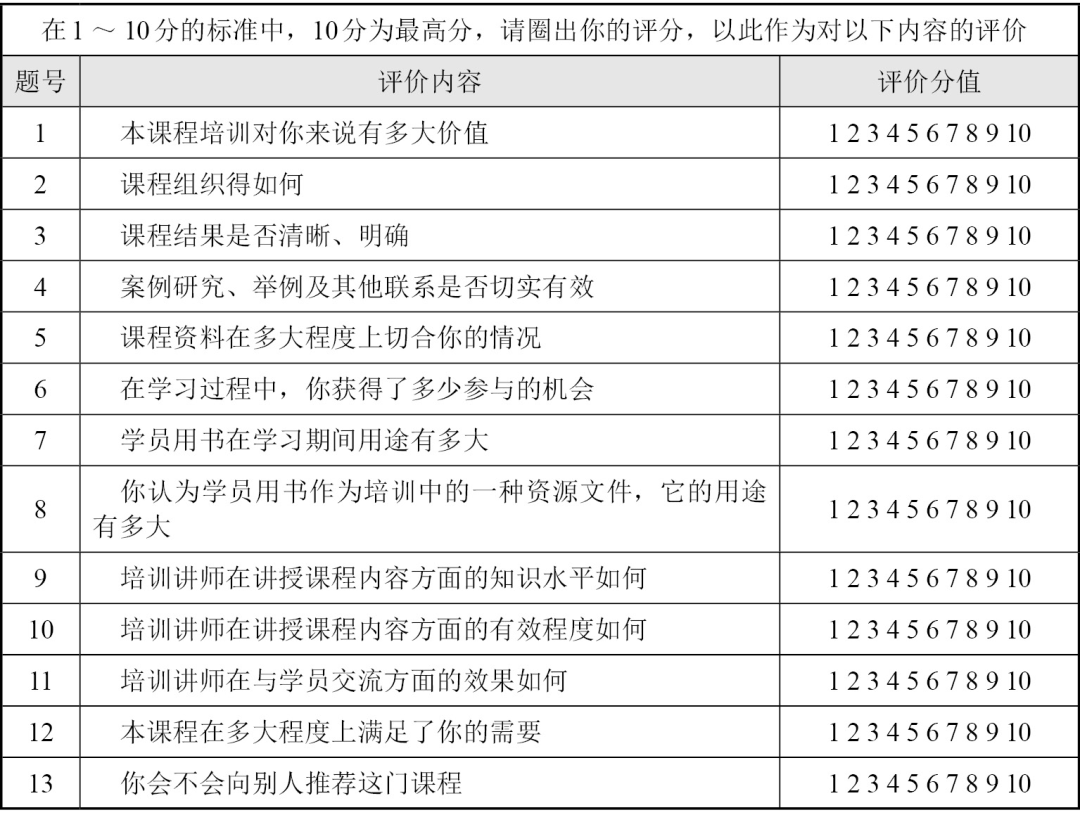
Table-3 Questions used in Short-answer evaluation

(4) Write a summary report
Based on the comments, the training results of the students, the evaluation of the training lecturers and the comments of the relevant personnel of the course design, a comprehensive summary report is written.
The report should involve the average score of the scoring questions in the participant evaluation form, and the tendency in the feedback comments should be recorded. The report should also contain the ratings and comments of people who did not participate in the trial lecture as a separate part. This approach will make the feedback clearer and help determine the priorities that need to be improved.
A summary report of the training evaluation is provided below for reference only.
【Practical example】
××Co., Ltd. Training Course Evaluation Summary Report
1. What do you think is the most rewarding thing about this training?
(1) 95% of the colleagues who participated in the training believed that they had re-familiarized themselves with and understood the advantages of the company's products and services, and improved some of their sales skills.
(2) 92% of the colleagues who participated in the training believed that they understood the positioning and development direction of the company's various departments.
(3) 82% of colleagues who participated in the training believed that they knew and understood the company's culture and determined the direction.
2. What is your favorite thing about this training?
(1) 72% of people who participated in the training liked the case discussion session.
(2) 69% of people who participated in the training liked the relaxed atmosphere and the excellent and patient lecturers.
(3) 97% of the people who participated in the training liked the sales training and the books they published.
(4) 82% of people who participated in the training liked experience sharing and product introduction.
(5) 79% of the people who participated in the training liked to clarify the company's positioning, requirements and development direction.
(6) 59% of people who participated in the training liked the training location.
3. What is your least favorite thing about this training?
(1) 2% of people who participated in the training did not like the outdoor expansion of the course.
(2) 1% of people who participated in the training did not like the teaching materials of the course.
(3) 2% of people who participated in the training did not like the short duration of the course.
(4) 3% of the people who participated in the training did not like that the training content of the course was relatively simple, not detailed and in-depth enough.
4. If we do this training again, what adjustments do you suggest we make?
(1) Improve the clarity of explaining the product.
(2) Do more case studies.
(3) The introduction of company management and marketing is best to be more specific.
(4) Add more content that is combined with practice.
(5) To increase sales explanations, it is best to have some professional training.
(6) Increase the opportunity to share successful cases.
(7) Improve the quality of training lecturers.
5. What is the training course you want to attend most?
(1) Participate in sales and case analysis training to increase the analysis of competitors.
(2) Centralized professional knowledge training.
(3) In-depth understanding of the specific content of the product and the actual problems and difficulties encountered in the operation, introduce some lessons that can be learned from and discuss new solutions.
(4) The number of people who like sales training and want to increase sales training opportunities is relatively large.
V. Curriculum revision
(1) Basis for curriculum revision
A new course enters the revision stage after evaluation. It is based on the comments of training lecturers, trainees, experts, curriculum design-related personnel, and training project-related personnel. The revision of the curriculum should be a continuous process.
(2) Frequency of course revision
The frequency of course revisions depends on the training environment of the course content. If the course is related to high-tech, it may need to be revised every two months; sales courses may need to be revised every six months; in an environment where there are no substantial changes, the course may only need to be revised every two years.
(3) Course revision process
(1) Determine the frequency of the revision process. To formulate a revision cycle, such as monthly, quarterly, annual, etc.
(2) Determine the scope of the revision process. To decide whether two kinds of revisions need to be implemented, namely the main revision and the minor revision. Major revisions are not as frequent as minor revisions, and major revisions may involve curriculum redesign, extensive content reorganization and updates, changes in objectives, and changes in the overall format and arrangement of the curriculum. Minor revisions generally involve only minor changes in content. Minor revisions are more frequent than major revisions.
(3) Announce the revised content. The revised content should be announced and explain what changes will usually be made in each revision. In addition, it is necessary to maintain flexibility to meet those content that does not meet the schedule, but does need to be revised in a timely manner.
(4) Solicit opinions and suggestions. You can solicit opinions and suggestions from students, experts and other relevant personnel of the training project, and change them at any time.
(5) File the revised opinions. The revised opinions received from participants, content experts, and relevant personnel of the training project shall be preserved.
(6) Number. The most important reason for numbering training courses is that it is easy to query page numbers and distinguish between different course versions. The numbering should reflect the characteristics and content of the course. For example, most courses only require a course number, a version number, and a coherent page numbering system.
6. Design course process
No matter what kind of training course, the training content is required to be organized in an orderly and logical manner, so that it is easy for students to understand. This is the first task of course designers-to organize the course content according to the logic of the course content.
A working procedure is given below, which will help course designers arrange the training courses clearly and logically, so that they can be better accepted by students. The training content arrangement procedures are shown in Table-4.
Table-4 Training Content Arrangement Procedures
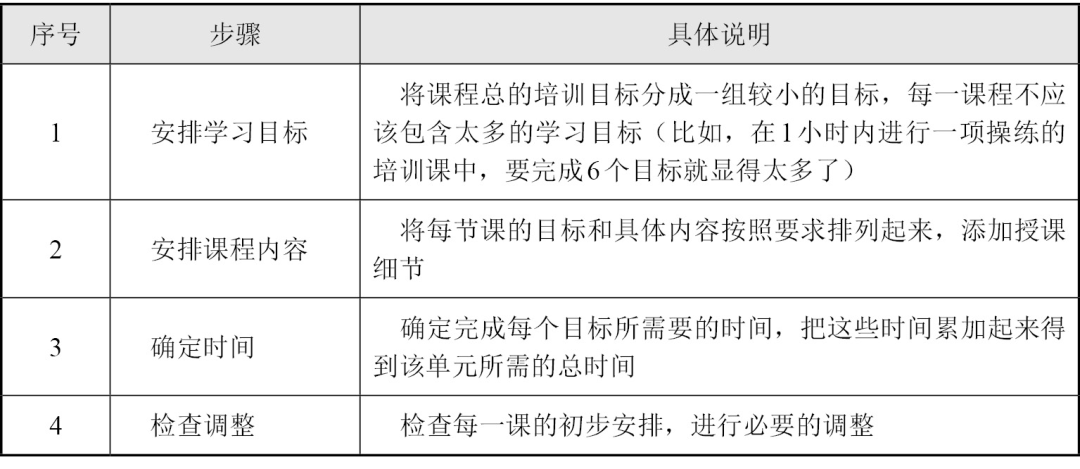
7. Arrange course time
In the process of arranging the course time, in addition to considering the logical order of the training content, the following principles must be followed.
(1) The maximum number of learning priorities per day cannot exceed 5, preferably 3.
(2) In the morning, students are energetic and can arrange more theoretical knowledge learning; in the afternoon, students have difficulty concentrating, so they should arrange more rest and activities.
(3) Taking from 9:00 to 17:00 as an example, at least one hour of rest time must be reserved every day, including one hour of lunch time and three 15-minute breaks.
(4) It is best to set aside half an hour a day to answer questions or deal with questions.
8. Prepare a student handbook
(1) The purpose of writing the student handbook
The student handbook is the student textbook, which is a material for students participating in group training. Students can familiarize themselves with the overall framework of the training course through the teaching materials, and they can also record the main points of knowledge, experiences and actions they have learned in the teaching materials.
(2) Content of the student handbook
The content of the student handbook should include courseware intent, learning goals, main topics, a course map that estimates the duration of each topic, and requirements for successful completion of the course.
Make courseware and slides
1. Making courseware
(1) Purpose of courseware production
The purpose of making courseware is to enable training lecturers to systematically interpret the knowledge to be taught during the training process. Scattered courseware that have not been carefully produced are difficult to function because it cannot effectively help the training instructor explain what is to be taught.
(2) Production steps of courseware
1. Theoretical knowledge
Theoretical knowledge is the central content of the training course. Training lecturers can look for this part of the information from related books, magazines, and the Internet around the theme of the training.
2. Related cases
The acquisition of cases can be through exchanges with relevant colleagues, usual observations and accumulation. If the training instructor has sufficient ability, he can also design corresponding cases by himself according to the needs of course development. No matter where the case is obtained, it must be targeted, that is, the scene of the case is indeed what students often encounter in their daily work. More importantly, the analysis of the case should be accurate and comprehensive.
2. Make a slideshow
A slide show is a computer presentation that combines sound, image, and text. Its biggest advantage is to stimulate students' interest in learning and to outline the lectures of training lecturers. The training instructor can list the outline and main steps in the slide show in order to show the demonstration to the students in the classroom.
(1) Slideshow production contains elements
The elements included in the slideshow production are shown in Table-5 for details.
Table-5 Slideshow production contains Elements
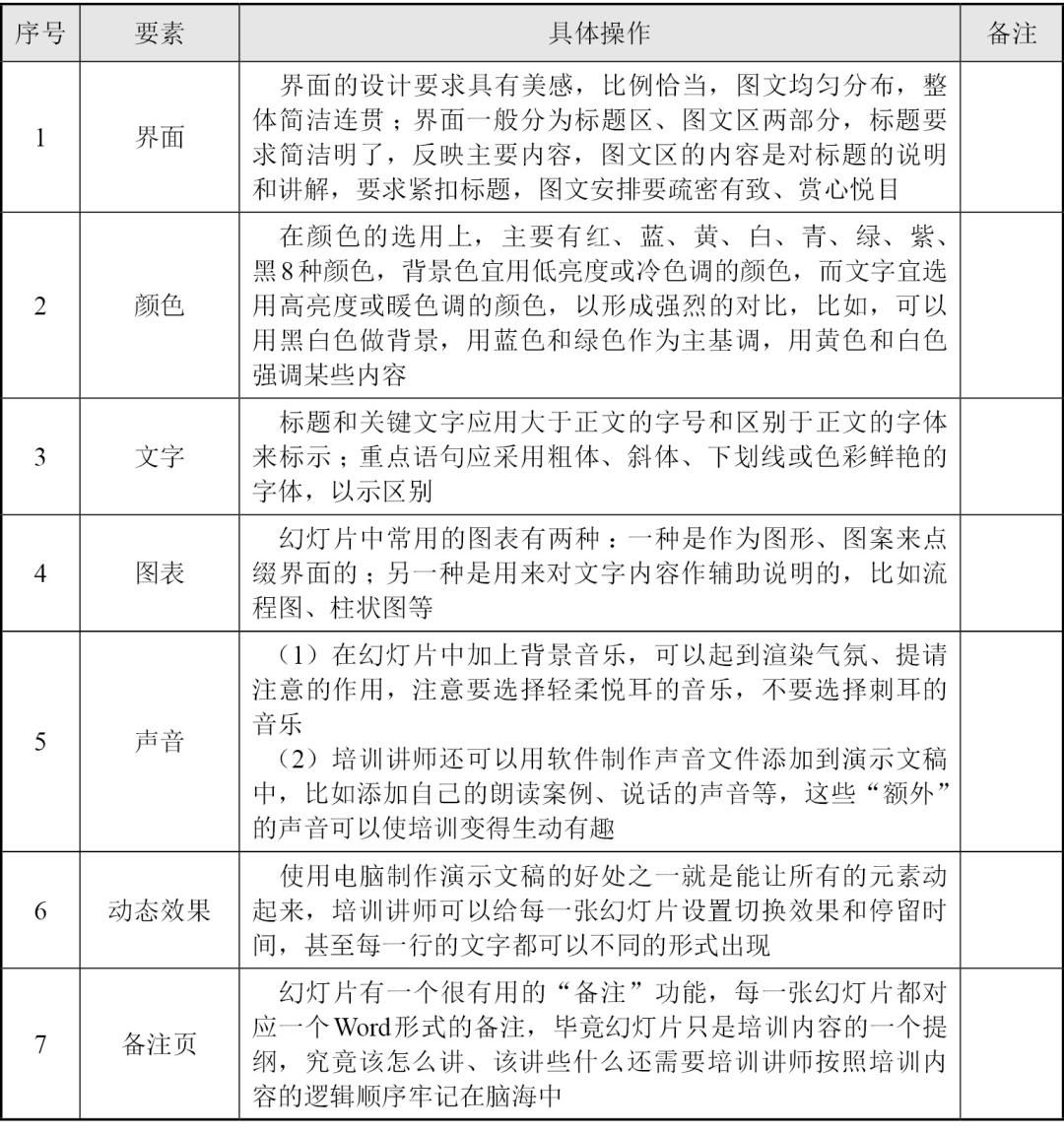
(2) Precautions
You should pay attention to the following when making slideshows.
(1) Simple, clear, and clear, each page expresses only one theme.
(2) The explanation of each page gradually deepens, using cartoons or other pictures to emphasize the focus.
(3) Use different colors to increase students' interest and activate the classroom atmosphere.
(4) Each page should not exceed 10 lines of text, and each line should not exceed 10 words.
(5) Do not use vague text or pictures.
(6) According to the distance of the projection, use different fonts, lines, and spatial positions on the screen rationally.


Leave a Reply